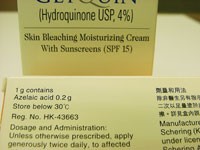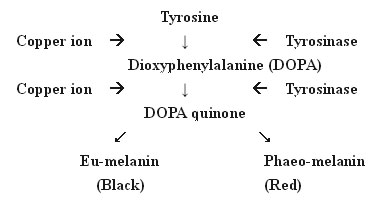
Melanin is made by the melanocytes in the basal layer of the epidermis. It is then transferred to the surrounding keratinocytes. It is lost naturally together with the keratinocytes as they migrate upward and shed at the surface, completing its own metabolism.
Hydroquinone is used mainly as a whitening agent. Hydroquinone products are popular for their skin-lightening properties in Asian and African cosmetics markets. In the U.S., they also are marketed for reducing age spots and blemishes. To understand how it and other whitening agents work, it is essential to know the synthesis process of melanin. The basic building block is tyrosine :

Hydroquinone can decrease the formation of melanosomes inside the melanocytes, as well as disintegrate their structures. It inhibits the tyrosinase, without which the entire manufacturing process is interrupted. It is a very effective whitening agent. It can fade many different pigment problems. However it normally takes at least a few months to see the result because it only blocks the making process, but cannot break down the already existing melanin, which needs time to get lost naturally. To enhance the effect, it can combine with tretinoin.
Hydroquinone is oxidized easily by the air and turns brown, but this does not affect the bleaching effect and can continue to be used. It is normally used only once at nighttime, because if used in the daytime and get exposed to sunlight, it could make the pigment worse. Some preparations mix it with strong sunscreen to allow for daytime use but it is best avoided.
It can irritate the skin a lot and cause redness. After the bleaching, the colour may not match that of the surrounding skin. The current concentration available is usually between 2 - 4%. If a higher concentration is used for a long period, it could lead to a pigment called Ochronosis, which is dark brown to black, and is not amenable to treatment. Another potential problem is the direct destruction of melanocytes, which can result in local white patches.
There are many skin-lightening products containing hydroquinone in the U.S. Currently, products that contain up to 2% of hydroquinone may be sold in the U.S. without a prescription, and prescription skin-lightening products may contain up to 4%.
Hydroquinone has already been banned in Japan, the European Union, and Australia, as the ban is being considered in the US. The reason is the potential Onchronosis as mentioned above, as well as some evidence that it may cause cancer in rodents animal, although its cancer-causing properties have yet to be proved in humans.

